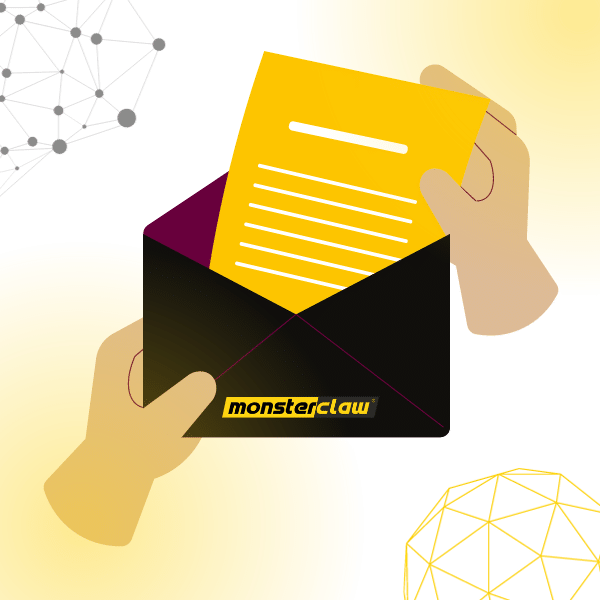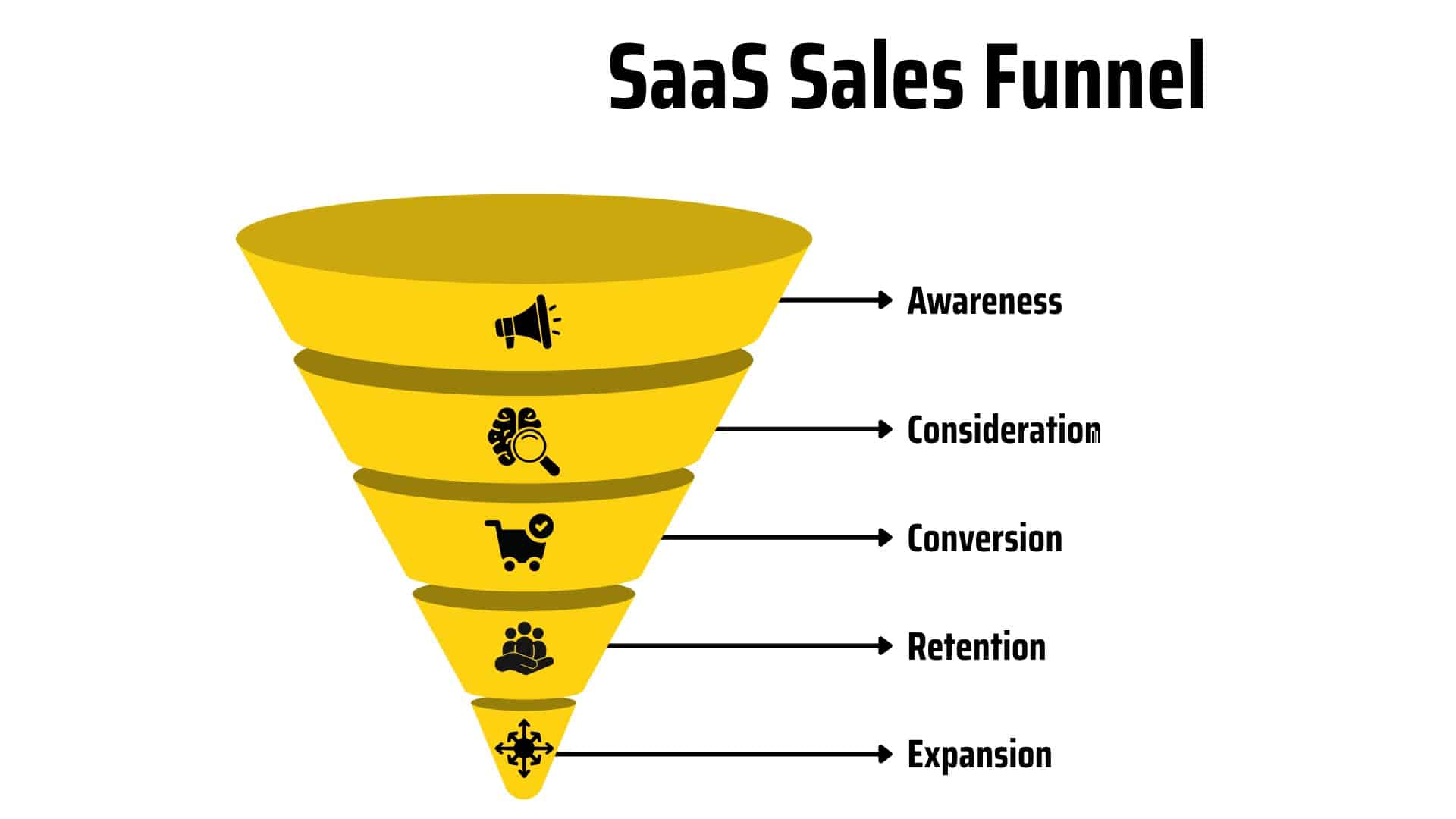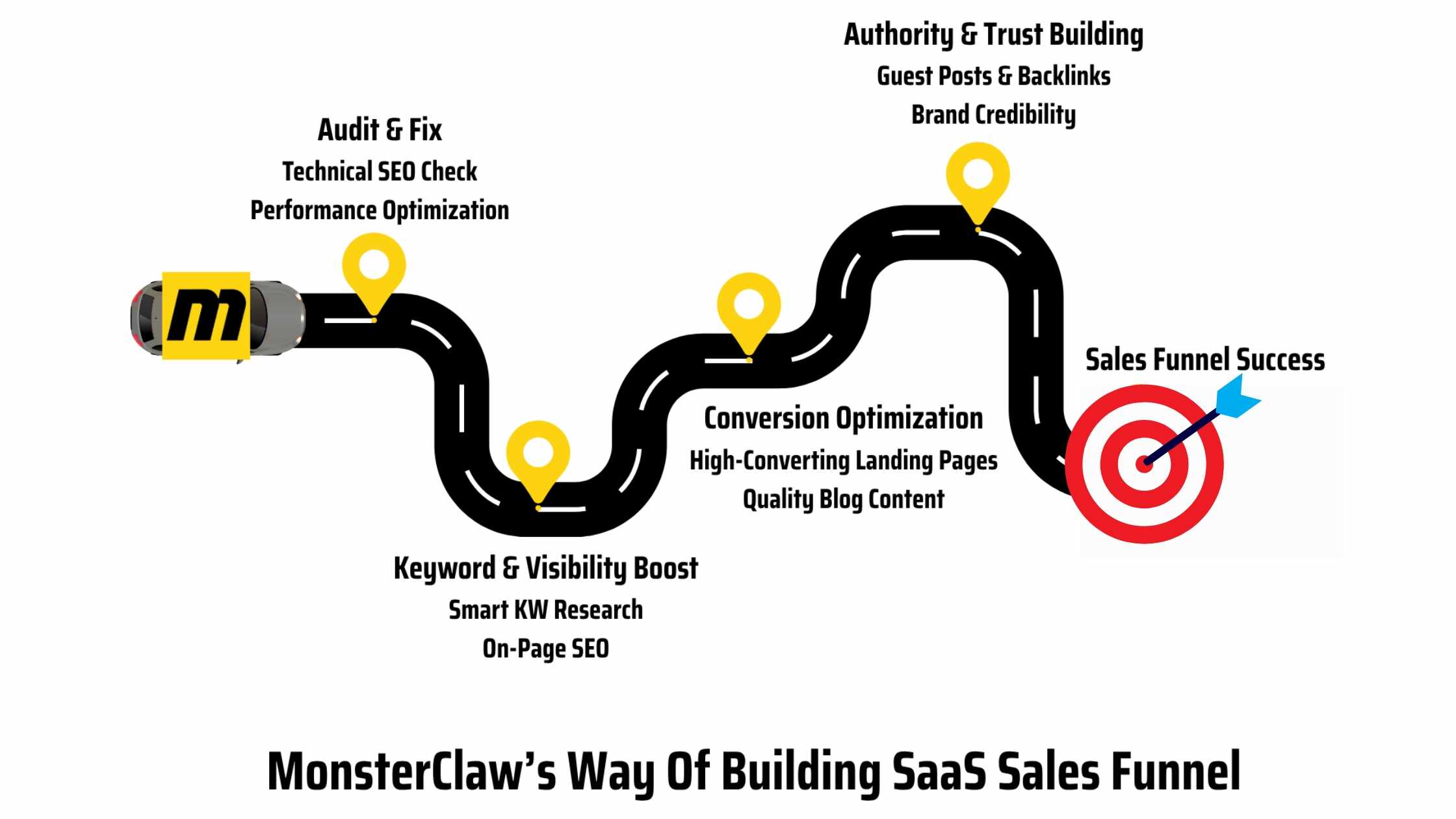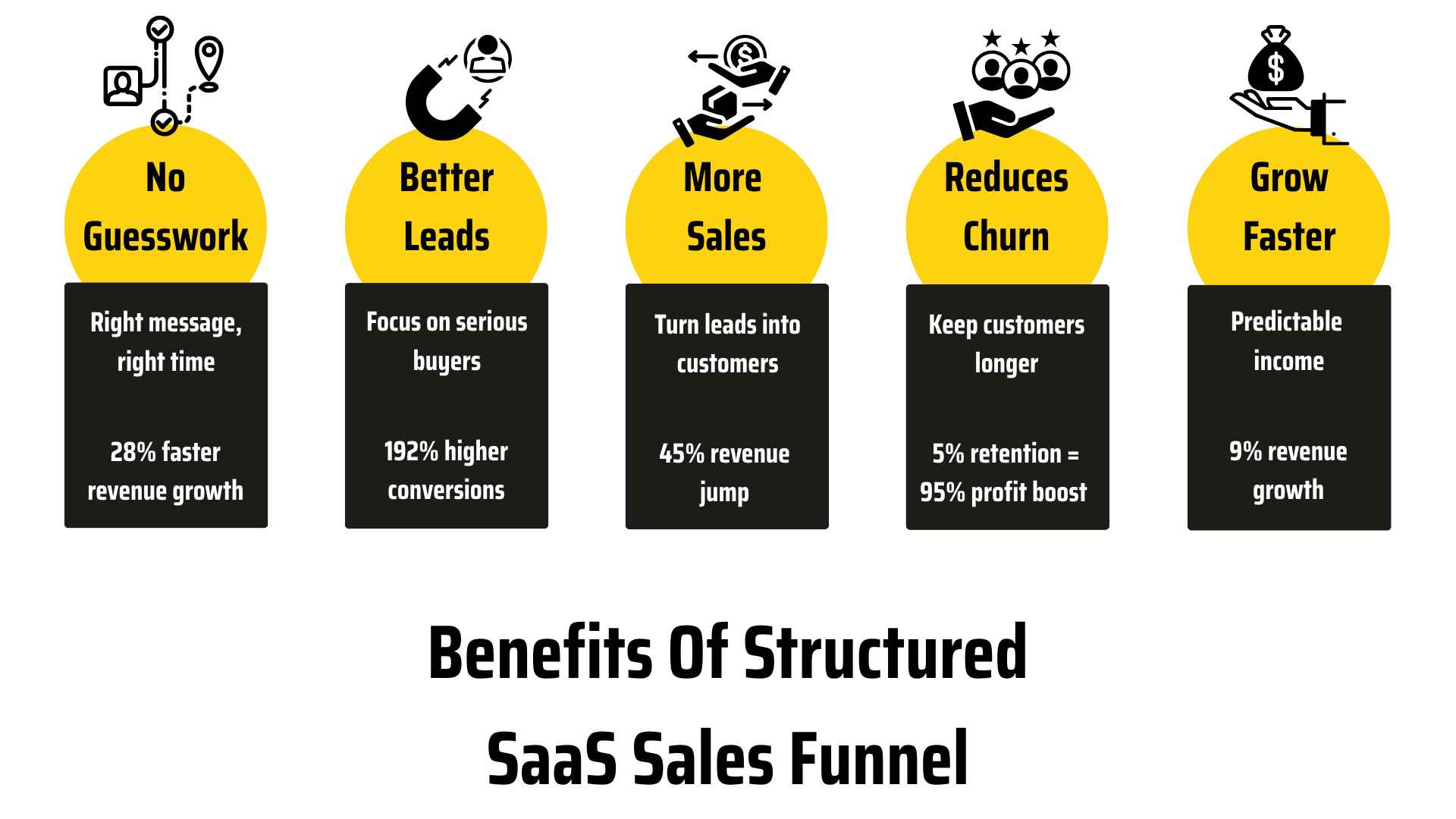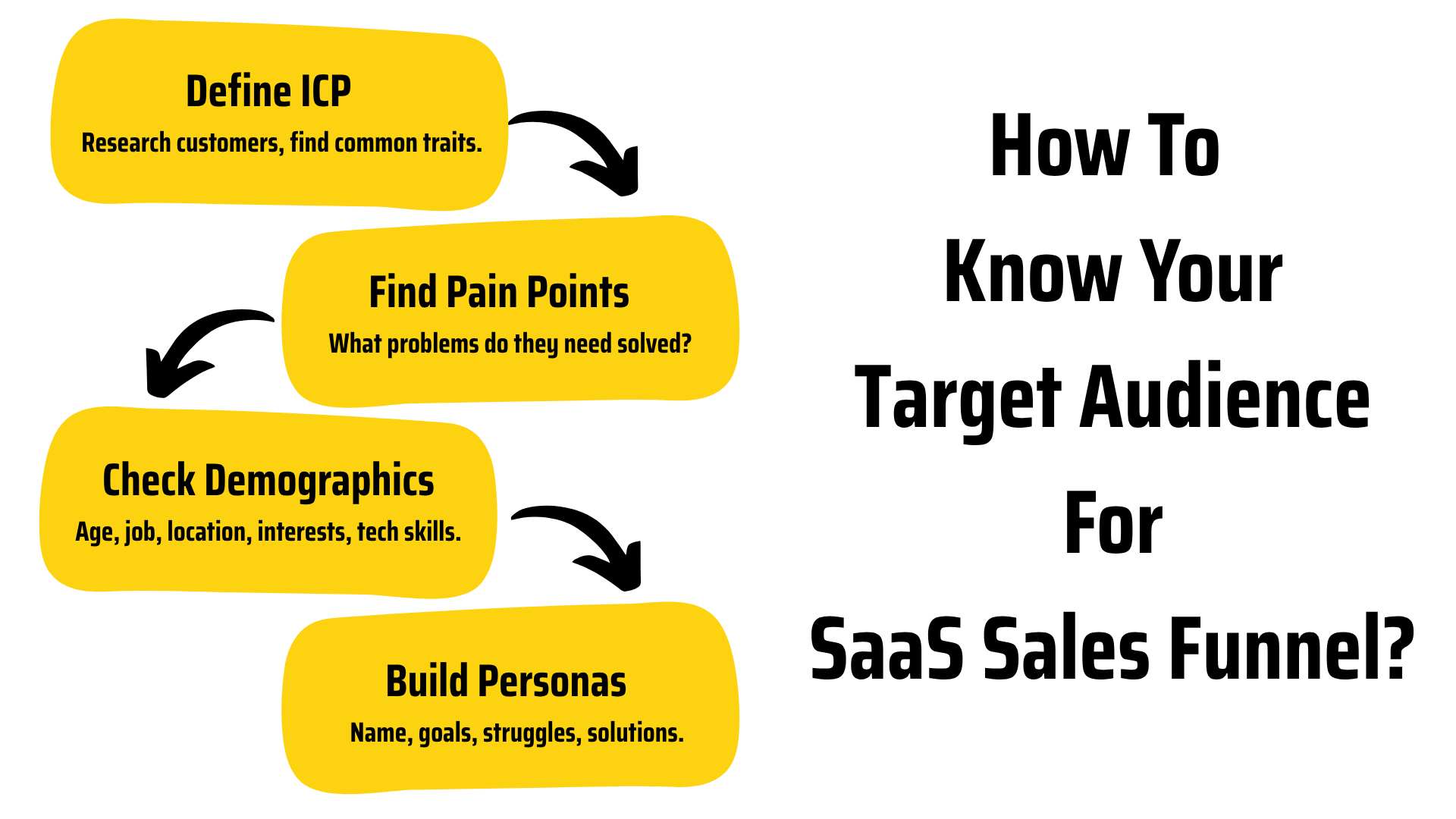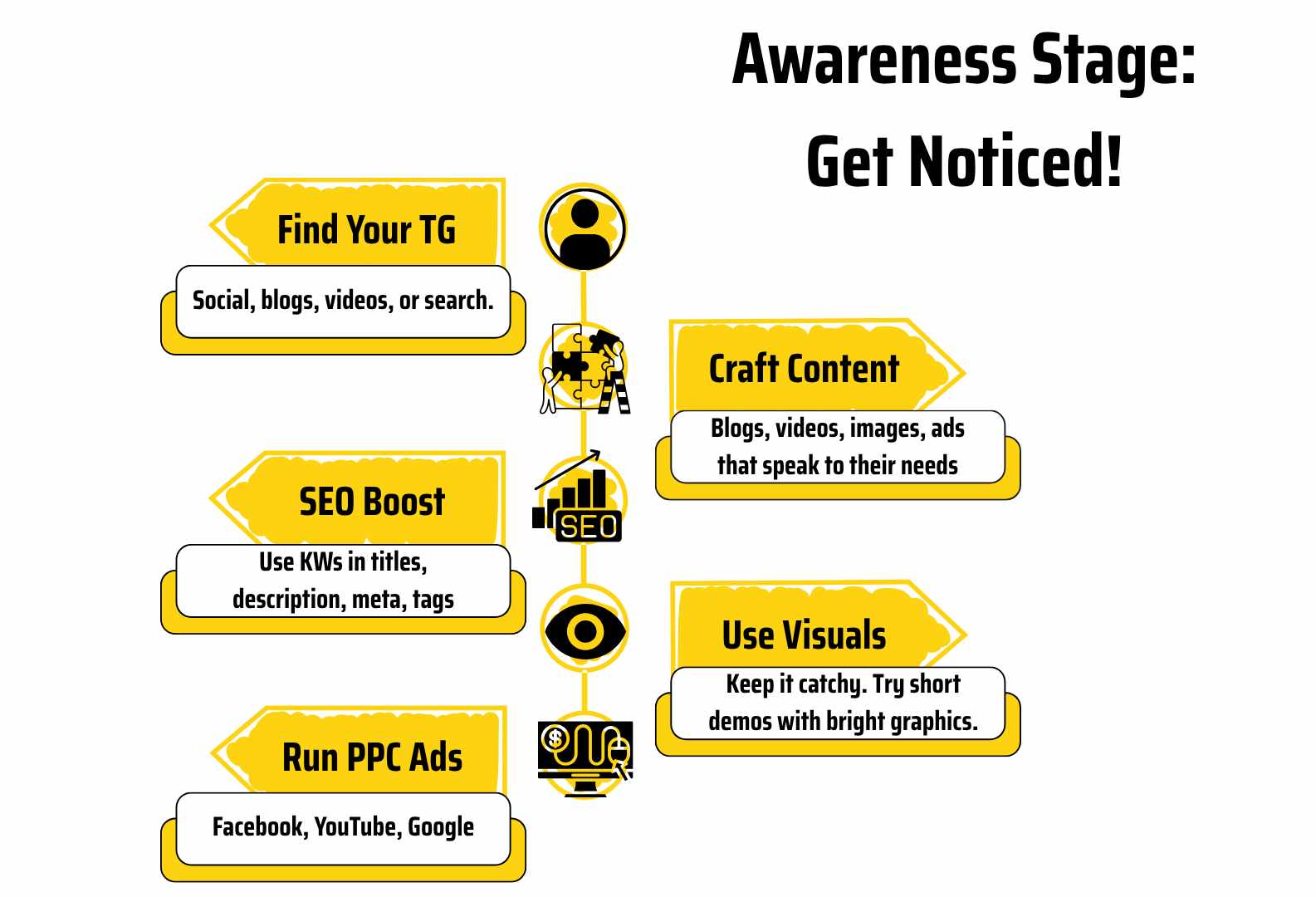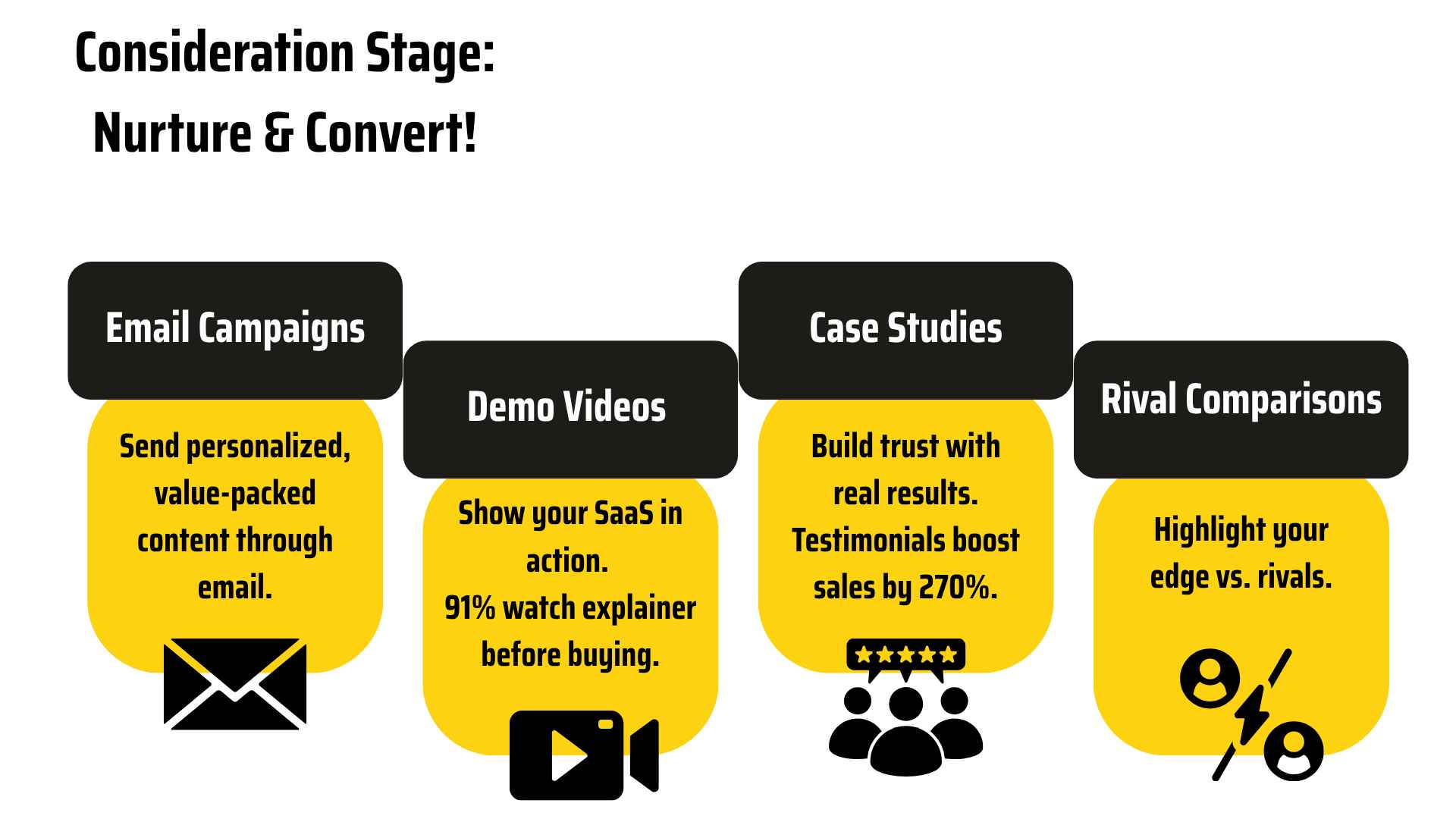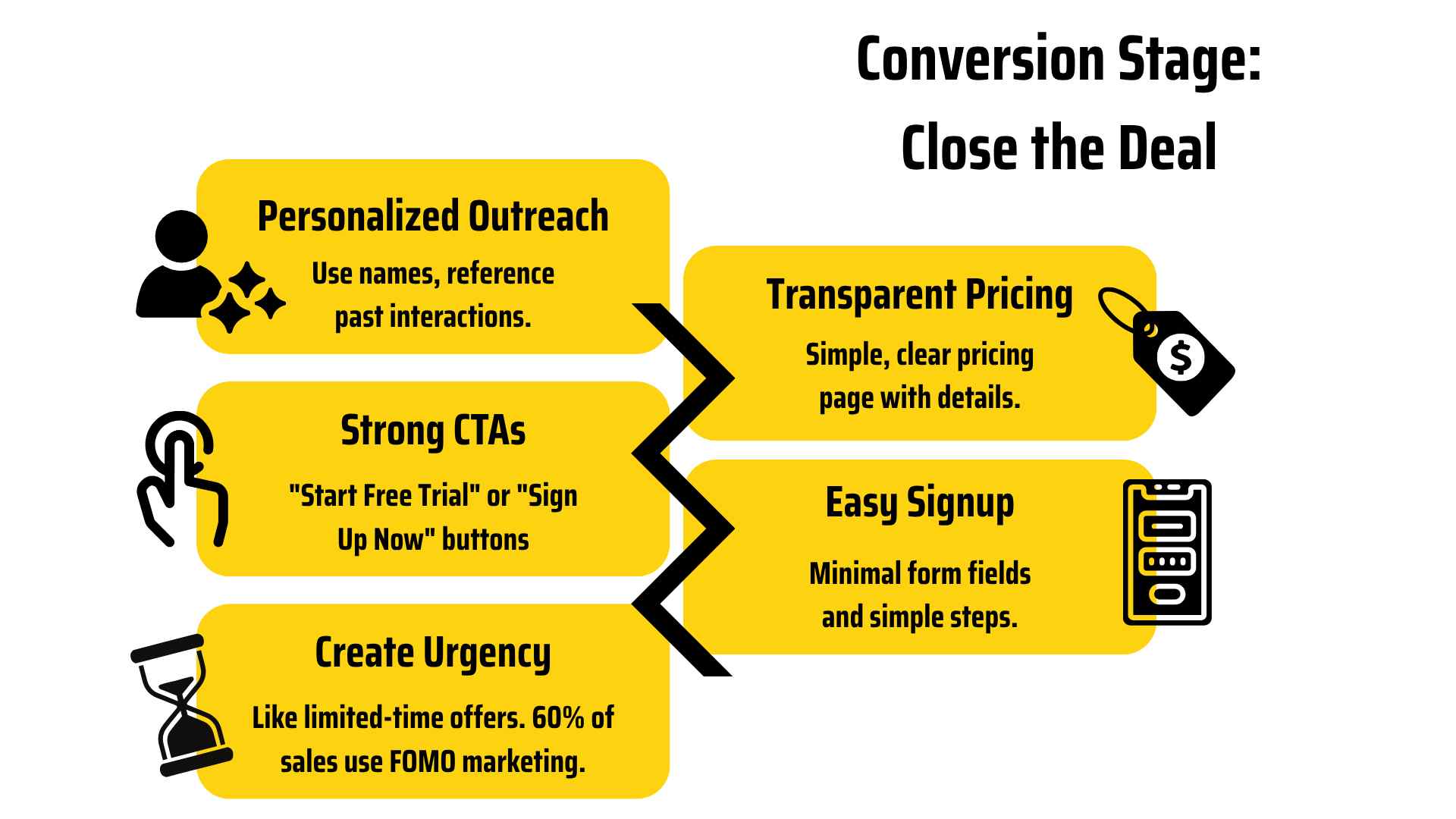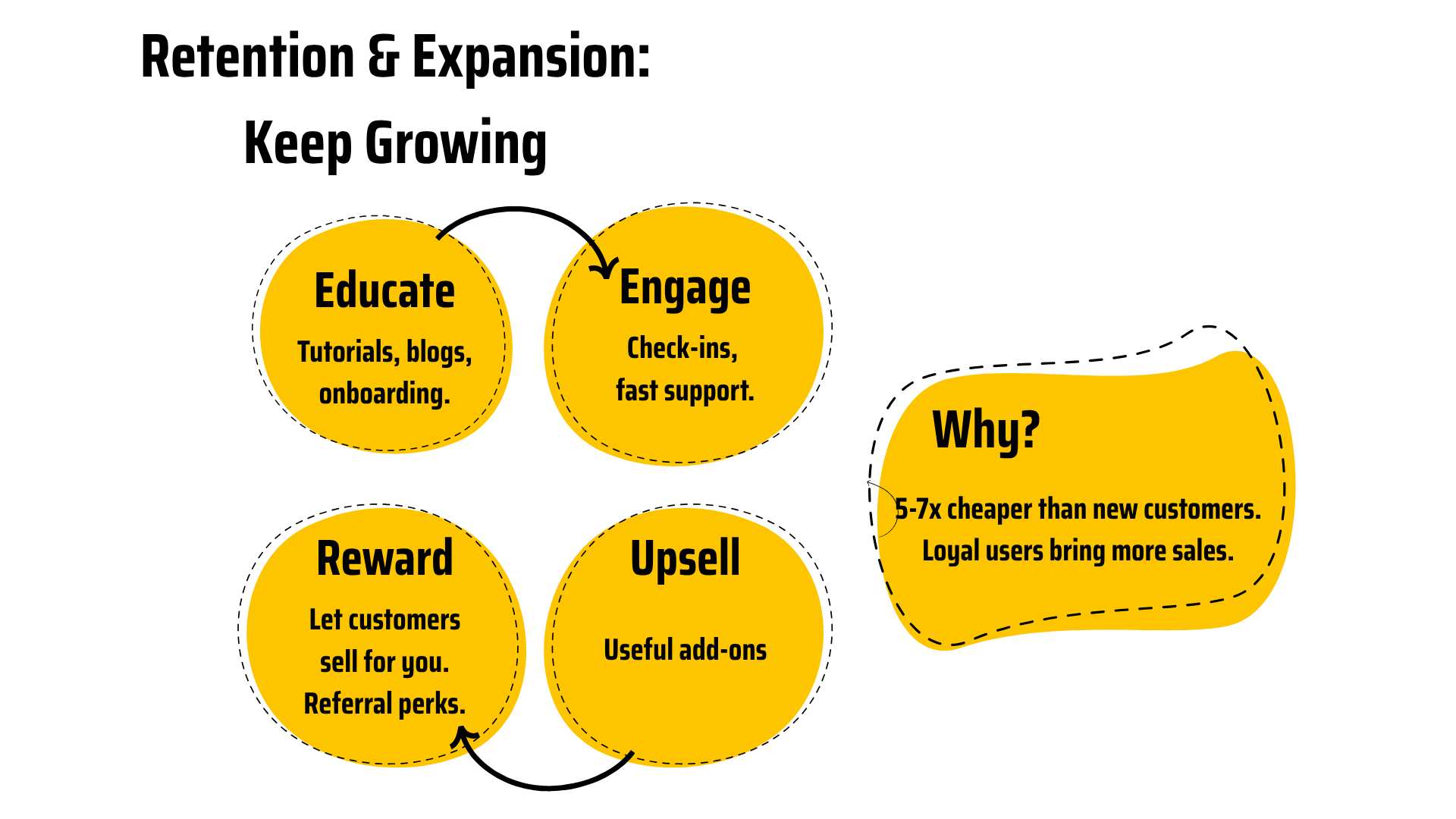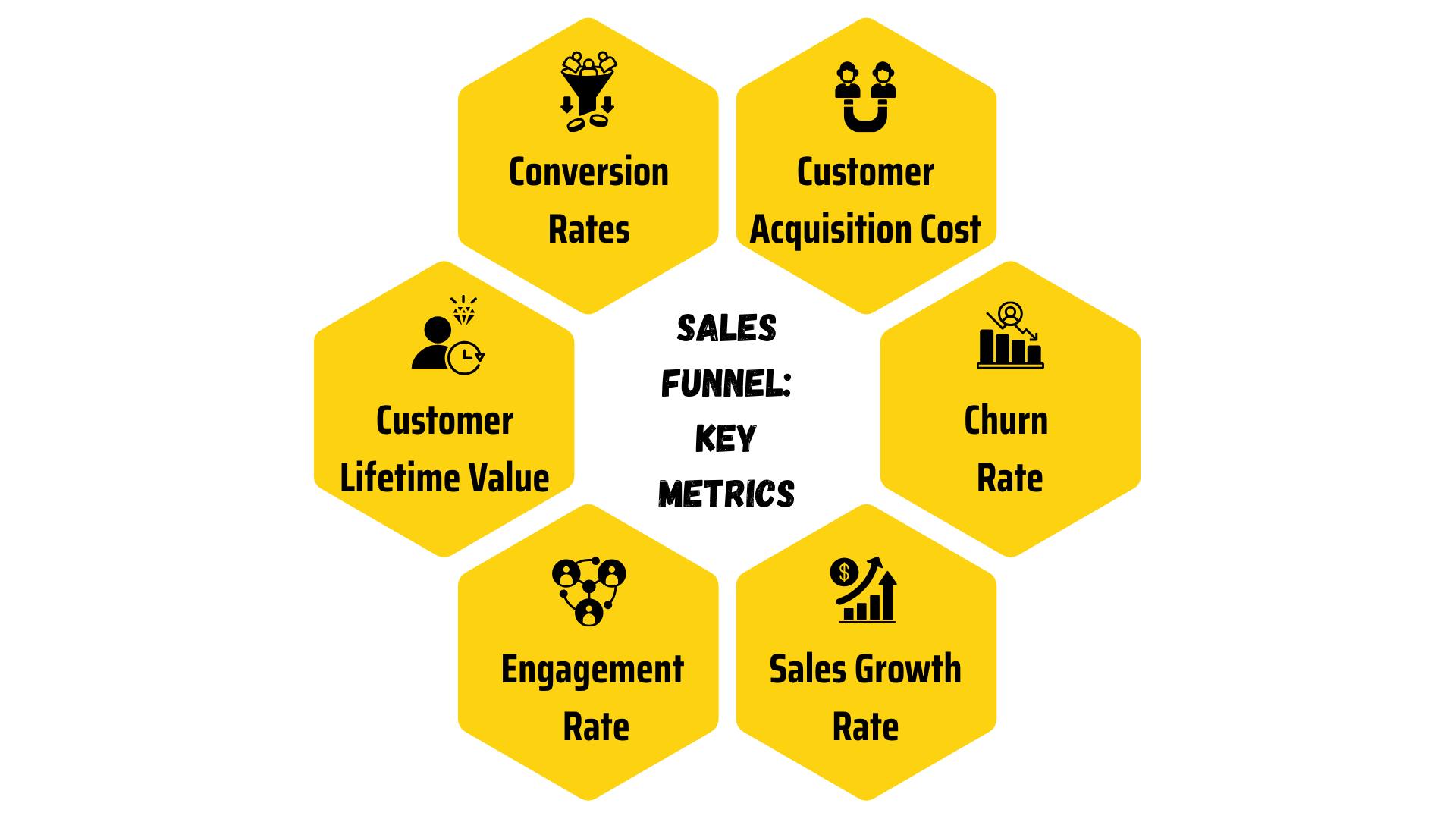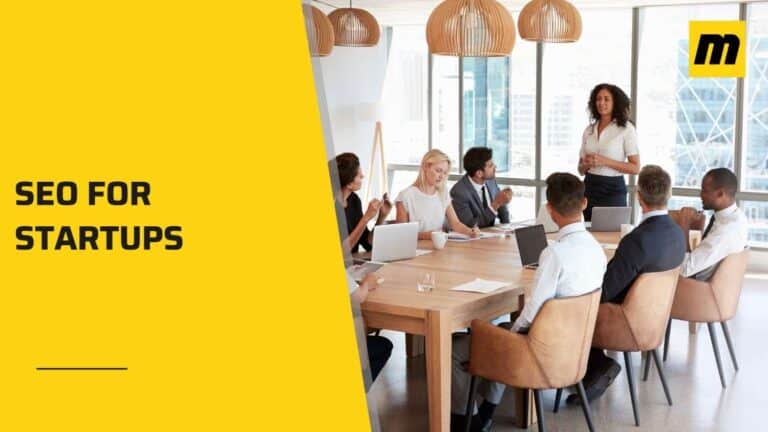Nobody dreams of your SaaS. Sell what they dream of.
People don’t buy tools anymore. They buy results. This is where the SaaS sales funnel steps in.
It guides people through each step, helping them become paying customers. This is like a path they take from first hearing about your software to clicking your CTA button.
However, note that only 3 to 5 out of every 100 visitors ultimately make a purchase. (Databox). It doesn’t sound like a lot, but it means real money in your pocket.
Then again, if your funnel isn’t set up the right way, this percentage can go lower.
So, what to do? Of course, building a high-converting SaaS sales funnel.
And how do you do that? Simple-
- Attract
- Engage
- Convert
- Retain
What Is A SaaS Sales Funnel?
A multi-stage selling process.
The SaaS Sales Funnel is a visual representation of a customer’s journey. It begins with building awareness of your software brand in people’s minds and extends beyond the initial payment.
It’s like a roadmap. You have different stages, and each serves a certain purpose.
The funnel helps you sort and guide the leads through the process of-
- Discovering a SaaS product
- Evaluating it
- Purchasing it and
- Reconnecting
It starts wide at the top and narrows down to a point at the bottom. The stages of a typical SaaS sales funnel include:
- Awareness: People learn about the SaaS product
- Consideration: Here, they evaluate your offering against others
- Conversion: They buy the software and become your customer
- Retention: It’s about keeping customers happy so they keep returning
- Advocacy: It involves upselling and cross-selling to existing customers
How MonsterClaw Helps In Building a SaaS Sales Funnel?
At MonsterClaw, we help SaaS companies build strong sales funnels that actually work.
First, we audit your website and fix any SEO or technical issues. That way, people can easily find you online.
To optimize your visibility, we do smart keyword research and find what your target users are searching for. Having proper SEO elements helps your site show up when users look for your service.
Besides, we improve your existing pages to convert better. We create helpful blog content that engages visitors and motivates them to take action.
We also get your brand featured on other websites through guest posts. This builds trust and brings in traffic.
All of this helps guide the right people through your sales funnel.
Result: visitors turn into paying customers.
Why A Structured Funnel Matters For SaaS Businesses
Streamlines the Customer Journey
Without a funnel, you’re basically guessing.
Guessing:
- Who your customers are
- When to contact them
- Whether they’re ready to buy
A well-structured funnel gives you a clear path. You know what to say and when to say it. This makes it easy for customers to navigate their options.
For example, when someone first visits your site, they’re just curious. Here, the funnel helps you send the right information to warm them up. It can be a free guide or demo.
A report by Harvard Business Review highlighted that “top pipeline performers grew revenue 28% more than others.”
That’s because they’re not winging it. Rather, they’re following a step-by-step process that works.
Improves Lead Quality
Not all leads are equal.
Some just browse. Some never buy.
A SaaS sales funnel helps separate the serious folks from the tire-kickers. About 79% of leads may not convert. So, you have to focus your energy wisely.
With a funnel, you can add filters.
Maybe they have to sign up for a free trial or answer a few questions. That helps you understand their intention and spot people who genuinely want your SaaS.
This saves your sales team time and effort. Eventually, what you get is a batch of qualified leads.
A HubSpot study shows that
“Companies using lead scoring can give you a 192% higher average lead qualification rate.”
Increases Conversion Rates
The goal is to turn leads into paying users, right?
A good SaaS sales funnel does exactly that. It gently persuades your leads and moves them closer to a “yes”.
You’re not selling too early or too late. Instead, you guide them with the right message at the right time. It can be in the form of emails, blogs, videos, or offers.
This helps nurture leads and build trust.
A case study by Dashly highlighted that “a SaaS company saw a 45% increase in revenue after optimizing its sales funnel”. That’s a powerful boost.
Promotes Customer Retention
Your funnel doesn’t stop after the software sale.
A solid funnel supports both existing and new users. It keeps them hooked with welcome emails, tutorials, check-ins, and good deals.
Eventually, it helps reduce churn.
The average churn rate for SaaS is typically 10-14% a year. But we suggest aiming for under 2%. Sales funnels help ensure that through personalized targeting.
When your customers feel prioritized, they stay for good and keep returning to you. This means higher scopes of driving revenue.
Harvard Business Review says that
“Increasing customer retention by 5% can boost profits by 25% to 95%.”
Drives Revenue Growth
It’s always about the revenue.
Sales funnels can help you make more money with less stress. They pull in leads, turn them into customers, and keep them loyal.
Particularly, when the funnel is well-structured, SaaS companies can see-
- More predictable income
- Better customer lifetime value (CLV) and
- Fewer lost opportunities
The more conversions and retention, the higher the revenue. After all, if customers move through the funnel effectively, your sales are bound to grow.
Even HBR says the same. They found that “sales teams with proper pipeline management could grow revenue 9% faster.”
How To Build A High-Converting SaaS Sales Funnel?
Understand Your Target Audience
You must know who you’re talking to.
So, define your ideal customer profile (ICP) first. Without knowing that, you’ll just shoot in the dark.
For this, research your current customers. Focus on who they are and what common traits they share. You can get this data through customer surveys and interviews.
Mark the pain points. Understand their challenges and problems. Then design your solutions accordingly.
Evaluate demographics. Look at their-
- Age
- Gender
- Location
- Profession
- Industry
- How tech-savvy they are
This helps you better personalize your message and content.
Finally, create buyer personas. Transform your research into specific personas that represent different segments of your target audience.
Ensure each persona has
- Background information
- Pain points and
- Solutions they look for
Build the Awareness Stage
Get your name out there.
The awareness stage is where your leads first meet you and your SaaS product. They may see your blog, social post, an online ad, or videos.
Awareness is important because if people don’t know your software exists, how will you sell it?
So, hook them early. The stage is mostly about showing up rather than selling.
To build awareness-
Consider where your audiences hang out the most. Is it on social media, video-based platforms, or search engines?
Are they into blogs, images, or videos? Create content that speaks to them.
Boost their visibility through SEO elements. Add winning and relevant keywords to the content, title, description, meta, and hashtags. SemRush highlights that top results on Google get 22.3% of all clicks. Proper SEO helps with that ranking.
Also, use bright, catchy visuals and simple messages. Try to share a short video showing how your software solves a problem.
If you have money, invest in pay-per-click ads during this stage. This helps widen your reach. Facebook, YouTube, and Google are popular platforms to target specific audiences.
Optimize the Consideration Stage
Here’s where you focus on nurturing your people.
The consideration stage is where you warm up the leads and get them excited about your SaaS. Your goal is to turn the interest into intent, meaning qualified leads.
For this stage-
Start with email marketing campaigns. Send them relevant and personalized content based on their interests. This keeps you top of their mind.
Share helpful resources and remind them of the benefits of your product.
Show your software in action. In this case, a SaaS explainer or demo works best. Because software is a technical product, many may not understand it from the get-go.
Such videos help simplify complicated topics and solve problems through visuals and animations. That’s why 91% of consumers watch an explainer before making a purchase. (Source: Vidico)
Also, share case studies and testimonials. Real-world examples build trust. Moreover, showing online reviews and feedback can boost sales by 270%. (Source: WiserNotify)
A witty thing to do is to compare yourself to competitors. You can do that through websites or content. Highlight the unique features and benefits your software has. Spot the weaknesses of your rivals and use them as your strength.
This helps people consider why you should be their top pick.
Strengthen The Conversion Stage
Time to seal the deal.
The conversion stage is where your leads become LEGIT buyers. It’s about guiding and persuading them to make that last leap and buy the SaaS.
Ensure the entire process is super simple so that they don’t back out last minute.
For this stage-
First, send targeted messages to leads. Give them special treatment like VIP. Use their names and reference their past interactions.
Don’t hide price tags. Ensure it’s easy to understand what they’ll get and why. A pricing page should be simple and direct.
Have a clear call-to-action (CTA) on your site and content. This can be a button saying “Start Free Trial” or “Sign Up Now”.
Remove unnecessary fields from signup forms. The fewer the barriers, the better.
Use persuasive techniques. For example, show how many people are already using your software. The benefits they’re getting the most.
A little urgency can help, like LIMITED TIME offers. Because “60% of sales are driven by FOMO marketing” (Source: ResearchGate).
Focus On Retention and Expansion
Cheers! You’ve made a sale. But that’s not the end.
This is where the post-sales spell starts. The retention stage is about keeping customers so happy that they keep returning.
Focus on retained customers because “getting new ones is 5 to 7 times pricier” (Source: Forbes).
Here, happy users will sell for you through positive reviews and higher ratings. That way, the fresh leads will get a boost while helping you expand.
Start with customer education. Give them training sessions, tutorials, and 24/7 onboarding support. This helps ensure long-lasting engagement.
Check in with customers daily. Check whether they’re satisfied. Address issues related to your product or service fast. It can help reduce churn.
Introduce extra features of your SaaS product that can benefit customers. Be their go-to resource for new tools and add-ons to your service.
Try to give a consistent value. Happy customers can refer others to you, along with sticking around.
Tools and Automation To Exploit
Funnels are mostly auto-work and slightly manual.
Here, other software can help your software shine. For the sales funnel, you can consider tools like-
CRM Systems
Customer Relationship Management systems keep track of all your interactions with customers. They help manage contacts and sales pipelines.
CRMs can streamline your funnel processes, automate follow-ups, scan behavior, and track leads.
Examples
- SaleForce
- HubSpot
Email Automation Platforms
Email auto platforms let you automate your email campaigns to save time. The most common features are-
- Personalizing emails
- Building email lists and
- Sending newsletters
Automating emails can help nurture leads and prevent them from going cold.
Examples
- AWeber
- Braze
Analytics Tools
Analytics tools scan customer behavior and sales data and provide insights into their preferences and pain points.
Such tools track
- User traffic
- Behavior and
- Interactions
You can use that report to understand what works and what doesn’t. That way, you can adjust your SaaS sales funnel strategy and fine-tune it.
Examples
- Google Analytics
- MixPanel
A/B Testing
This method involves testing two versions of a webpage or email. You see them to understand which performs better.
A/B testing mainly helps you find effective strategies based on actual data rather than guesswork.
Examples
- LaunchDarkly
- AB Tasty
Measure and Improve Funnel Performance
You must keep your eyes on the price. Check how your funnel is performing. Evaluate each data and adjust accordingly.
Here are some key metrics to measure the health of your SaaS sales funnel.
Conversion Rates
Track how many leads are moving to the next step in the funnel. The spot where people drop off and optimize those stages.
Customer Acquisition Cost
Know how much you spend to acquire each customer. The lower your CAC, the better your margins.
Customer Lifetime Value
Understand the total revenue you expect from a customer over their entire relationship with your business. The goal is to have your CLTV higher than CAC.
Churn Rate
This shows how many customers stop using your software service over a specific period. Keep this number low. Focus on retention efforts.
Sales Growth Rate
Measure your revenue changes over time to see if the strategies are effective. The higher the returns on investment (ROI), the better.
Engagement
Track interactions with your emails, website, and social media. Higher engagement suggests you’re hooking people effectively and that they like the software.
Common Mistakes To Avoid
| Mistake | Solution |
| Ignoring retention | Focus on onboarding and support |
| Only chasing new leads | Nurture existing leads and balance efforts between all stages |
| Complicated setup or process | Reduce form fields and simplify steps |
| Misaligned sales and marketing | Regular sync-ups and foster communication |
FAQs
What Are The 5 Stages Of The Sales Funnel?
The 5 stages of the sales funnel are awareness, consideration, conversion, retention, and expansion.
What Is The Top Of The Funnel In Saas?
The Top of the Funnel in SaaS is the Awareness Stage. This is where leads first learn about your software as a service.
What Are The Metrics For Saas Funnel?
Metrics for the SaaS funnel include the conversion rates at each stage, customer acquisition cost, customer lifetime value, churn rate, customer satisfaction score, and net promoter score.
What Is The Difference Between a Sales Pipeline And Sales Funnel?
The sales pipeline focuses on the stages of sales process, whereas the sales funnel represents the entire customer journey from awareness to expansion.
What Is Another Name For A Sales Funnel?
Some other names for sales funnel are purchase funnel, marketing funnel, or revenue funnel.
